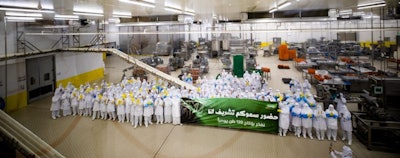
Saudi Arabia is expected to record an increase in its broiler production this year, with output rising from an estimated 910,000 metric tons in 2021 to 950,000 metric tons.
The main factor behind this increase will be the completion of an Al Watania poultry expansion project, which will raise the company’s production from 850,000 to 1 million birds per day. The Al Watania investment, however, is not the only investment contributing to more chicken production in the country and, early last year, Almarai announced that it would be investing US1.8 billion over the next five years to double its poultry activities.
The upturn in local production comes after a year in which the local market has witnessed significant changes. Like other markets, Saudi Arabia has had to adapt to COVID-19 restrictions. However, the market for chicken, the most consumed meat in the country, is thought to have been particularly affected by the return home of migrant workers.
Looking ahead, demand this year should be particularly strong as the economy gradually returns to normal, opening to workers and visitors alike, reports the U.S. Department of Agriculture's (USDA) Foreign Agricultural Service (FAS).
Favorable circumstances for broiler producers
Local chicken producers find themselves in a particularly fortuitous position. The government is keen to increase the country’s food security and gives particular support to sectors deemed to not be wasteful of water, and this includes the chicken industry.
Various measures have been introduced to foster the sector’s expansion, with support available to encourage new chicken enterprises and to expand those already in operation. Purchasing land and gaining permission to establish farms has become easier, and loans and subsidies are being made available for investment in equipment, for example.
Several companies that traditionally exported to the country have now established local operations.
Saudi Arabia is 60% self-sufficient for chicken meat. However, the government wants this to increase to approximately 85% by 2030. Alongside this drive for self-sufficiency, the government is also trying to rebalance the economy, with tourism being one of its favored industries. As tourism expands in the country, demand for chicken meat is likely to rise with it.
For 2022, chicken meat consumption is forecast to reach 15 million metric tons, an increase of 3%.
Broiler meat imports
While Saudi Arabia remains highly reliant on poultry meat imports, the government, nevertheless, restricted market access for several major exporters to the country last year.
It suspended imports from 11 Brazilian processors, accounting for 60% of Brazil’s exports to the country, due to concerns over Salmonella. This was followed by a suspension of imports from Ukraine’s largest export facility and then followed by import suspension on chicken from three French provinces.
Saudi consumers are said to favor locally produced meat, and imports are thought to have fallen by 16% in 2021, despite initially rising at the start of the year. This year, they are expected to start rising again. According to estimates from the USDA FAS, imports will grow by 4% to 540,000 metric tons this year.

















